|
Tags: archaeology | craft
The project of “Digital Archive of Archeological Collections in Central Taiwan” since it was launched in 2001. Meanwhile the digitalization of collections regarding the following topics have been completed: Yingpu Culture (containing the Site of Yingpu), Damalin Culture (including the Sites of Damalin and Shuiwaku), Fanzihyuan Culture (including the Sites of Qingshuei, Fanzihyuan, and Luliao), and Han Culture (including the Site of Bantou Village and Benxique at the Site of Benkang). The project consists of photos on field study, stoneware, pottery, ceramics, money, ironware, bone objects, and glass beads. The project aims to present the archeological data of items unearthed in central Taiwan to the public through digital technology, by means of images, texts, videos, 3D virtual models, and interaction games.
Sites of Yingpu Culture (dated from 2000 to 3500 years ago) can be found around the coastline of central Taiwan and riverside areas inland. The present project focuses on Yingpu Culture, which features pottery mainly in gray or black colors, followed by rustic. The stone wares include knapped stone hoes, stone adze, pikes, and net sinkers. In 1999, the Archeological Department of Anthropological Section of National Museum of Natural Science excavated the sites and discovered “ash pits” (dumping sites) of ancient times. It is speculated that rice was planted in central Taiwan at that time, according to the prints of rice husks on the ceramic pieces unearthed from the sites of Yingpu Culture.
Damalin Culture includes the Sites of Damalin (dated from 1600 to 4000 years ago) and Shuiwaku. Given the impact of geographical location, the essence of prehistoric culture at the Site of Damalin may have been influenced by other cultures. For example, influences from Peinan Culture (in Eastern Taiwan) or Fine Red Corded Terracotta Culture (in Central Taiwan) are significant in the sites’ slate coffins, jade crafts, and pottery made of orange gravel. In addition, influences of Yingpu Culture (on the western coastline in Taiwan) can be seen in the texture of black pottery, emblazonry patterns on the objects, and shapes and production styles of some stone wares found at the Site of Damalin, though such influence may occur at later time. Furthermore, some unique types of stone wares in the Site of Damalin, such as dagger axes, multi-hole stone objects, saddle-shaped stone knives, and knapped stone piece wares, were not unearthed at other prehistoric sites. It indicates that the site's culture is complicated and unique, hence the name “Damalin Culture”. The site of Shuiwaku, however, features a majority of Gray-Black Pottery Culture and Plain Red Pottery Culture, with only few wares from the Fine Red Corded Terracotta Culture and black pottery of Yingpu Culture, which were engraved with intricate lines and specific dot patterns.
Fanzihyuan Culture was popular on the coastline of central Taiwan from 400 to 2000 years ago. The Culture ranged from Datu Mountain Terrace in Taichung County, then reaching southward to Pakua Terrace and northward to the hills along the southern coastlines of Miaoli County. Sites of Fanzihyuan Culture include: the Fanzihyuan Site in Dajia Township, Taichung County, the Site of Luliao in Shalu Township, and the Site of Hueilai Village in Taichung City. Shell dumping sites are common at the sites of Fanzihyuan Culture; the majority of the objects are fine black and gray pottery, followed by rustic pottery. There are few stone wares, usually stone knives made of gravel, shinning saddle-shaped stones, and stone hammers. The iron knives were unearthed at the Sites of Fanzihyuan, Luliao, and Hueilai Village, which indicates the coming of iron age. In addition, face-down burials were found in the Sites of Fanzihyuan, Lulia, and Hueilai Village. The stone knives, shells, and animals’ bone suggest that people at that time lived on rice agriculture, shells gathering, and hunting.
The Sites of Bantou Village and Benkang are examples of Han Culture. Bantou Village is located at the south coast of Beigang River. According to the elderly local residents, the Village used to accommodate the office of the local government of Jiayi (formerly ‘Jhuluo’) and Bengang Counties in Ching Dynasty. In addition to the ruins, the unearthed items in Bantou Village are mostly pottery. For instance, the ceramic wares include underglaze blue and white porcelains, color-glazed porcelains, white china and few blue china wares. Concerning the type of wares, there are bowls, plates, dishes, terrines, cups, and soup spoons. Most of underglaze blue and white porcelains unearthed in Bantou Village were fired in the private kilns in Dehua, Ansi, and Yongchun of Fujan Province. Other items include black and white chess, bronze coins, bronze hair pins, and bronze pipes. The whole layout of the building is unknown due to the limited area of excavation. No evidence can be used either to prove that the house was used as the office of the Bengang County Government. However, it is known that the house may have been built around Yong Chen and Taokuang Reign of Ching Dynasty. The inhabitants of this house may have been gentlemen or rich businessmen, rather than common citizens. The name “Benkang” used to refer to areas near Beigang Township of Yunlin County and Nangang Village of Singang in Jiayi County, which used to be an important port in Qing Dynasty. The Benkang area was among the places in which the Han people arrived earlier for development. It was prosperous in old days, hence the sayings “Tainan is the First, Benguang the Second, and Mengjia the Third.” In the past, the Beigang River used to caused catastrophes as it usually overflowed in summer and even altered its routes often, destroying or flooding some cities and streets. Consequently, a considerable amount of antiques were available underground in the old Benkang. In 2003, the Archeological Department of Anthropological Section of the National Museum of Natural Science excavated numerous antique coins, particularly those circulated in Qing Dynasty. A great number of bronze accessories were also unearthed, including hair pins, rings, earrings, bells, tiles, and ceramic pieces.
Institute: National Museum of Natural Science
Program: Digital Archival ProgramsDigital Archives Program on Anthropology
|
Polished Square Stone Knife from the Site of Yingpu
This polished square stone knife was unearthed at the Site of Yingpu in Dadu, Taichung County. Two holes can be seen on the knife, of which the right and left edges are v-shaped; this is unusual of its kind. The knife can be dated to approximately 2000 years ago.
|
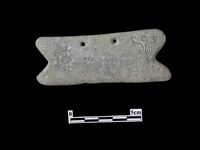 |
|
Knapped Stone Scraper from the Site of Damalin
This knapped scraper was unearthed at the Site of Damalin in Puli Township, Nantou County, in 2001. The scraper is oval, with a flaked surface on its back. Its upper part is significantly thicker than the bottom . One side of the scrapper is shaped as a blade, with signs of erosion caused by contact with soft objects. This indicates that it might have been used to cut or scrape.
|
 |
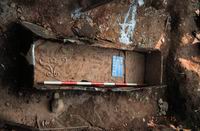 |
Stone Coffin from the Site of Damalin
This stone coffin was unearthed at the Site of Damalin in Puli Township. The coffin is 185 cm in length, 50 cm in width, and 30 cm in height, with its he long axis bearing West 24 degrees North. No human remain was found in the coffin, probably because the corpse has fully decomposed . No mortuary object was found, either. This coffin is dated to some 2000 years ago.
|
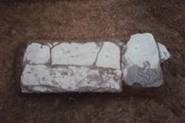 |
Grave in Shuiwaku Relics
This square coffin was unearthed at the Site of Damalin in Puli Township in 1997. The coffin is only 100 cm long and 32 cm wide. It may be the coffin for a child. Each of the two sideboards of the coffin constitutes two stone plates. There are six stone pieces and two stone pieces on the cover and the bottom of the coffin respectively. No human remain was found in the coffin, probably because the corpse has fully decomposed. Only one jade pendant was found as a mortuary object. This coffin is dated to some 2000 years ago.
|
|
Knapped Stone Hoe from the Site of Shuiwaku
The knapped stone hoe was unearthed in the Site of Shuiwaku in Puli Township. It was made of sandstone. There are significant signs of wearing on one side. It may have been used as a digging tool. The stone hoe can be dated to some 2000 years ago.
|
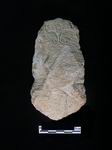 |
|
Fragment of a Ring-Patterned Pottery from the Site of Shuiwaku
The fragmented wrack is from the mouth of a gray pottery container made of coarse sand. The artifact's neck was decorated with patterns of circles, spots, and lines. It can be dated to some 2000 years ago.
|
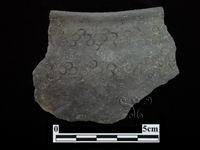 |
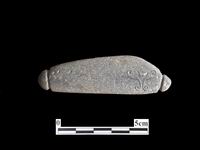 |
Net Sinker from the Site of Shuiwaku
This net sinker was unearthed at the Site of Damalin in Puli Township in 1997. Made of schist, it has furrows on both sides. The net sinker may have been attached to a fish net to make it sink into the water. The sinker is dated to some 2000 years ago.
|
 |
Human Skeleton Head from the Grave at the Site of Qingshuei
Human remains of a male adult were unearthed in the M2 grave at the Site of Qingshuei in Qingshuei Township, Taichung County, in 1998. The buried man faces down, with his limbs stretched and both hands apparently tied on the back. The man is about 170 cm tall, aged between 35 and 45 years old. The man had supragingival, probably because he used to chew things or use his teeth as tools in sewing, weaving, and making fish nests.
|
|
Bottom of a Pottery Steamer from the Site of Qingshuei
The pottery steamer was unearthed at the Site of Qinghuei in Taichung County in 1998. It was used to steam food. Rice was firstly put in this steamer, and when cooked with steam generated from another pottery pot beneath it. The steamer looks like a pot with a hole in the center of the bottom.
|
 |
|
Faced-Down Human Skeleton from the Site of Fanzihyuan
This faced-down human skeleton was unearthed in the north of Tzuchu Temple at the Site of Fanzihyuan in 1998. While the upper part of the body was well preserved, the part below the waist has already been destroyed. The human remains belong to Fanzihyuan Culture, dated some 1000 years ago. The person buried may be the ancestor of the Doukas or the Papora of the Pinpu Tribes.
|
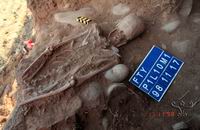 |
 |
Hair Pin Made of Animal Bone from the Site of Luliao Relics
Made of animal bone, the hair pin was unearthed at the Site of Luliao in Shalu Tonwship in Taichung County. It was made and used by the Papora of the Pinpu Tribes, dated to 500 or 600 hundred years ago. According to Shujiang Huang's account of clothes and ornaments in “Customs of Aboriginal Tribes” and ”Tribes in North Road of Jhuluo” in his report entitled A Chinese Inspector's Travel Accounts of Taiwan, “The hair pin on a man's head is called Dala.”
|
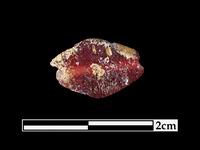 |
Red Glass Beads from the Site of Luliao Relics
This red glass bead was punched with a hole in the center; its surface was already eroded. It was unearthed at the Site of Luliao in Shalu Tonwship in Taichung County. It can be dated to 500 or 600 hundred years ago. The bead belongs to the Papora of the Pinpu Tribes and was obtained through trade. According to Shujiang Huang's account of clothes and ornaments in “Customs of Aboriginal Tribes” and ”Tribes in North Road of Jhuluo” in his report entitled A Chinese Inspector's Travel Accounts of Taiwan, “The bead was worn as a pendant.”
|
|
Green Glass Bead from the Site of Luliao
This green glass bead has a hole in the center. Two protruded sides appear as spirals, indicating the craftsmanship of the artifact. It was unearthed at the Site of Luliao in Shalu Tonwship, Taichung County, in 2000. It can be dated to 500 or 600 hundred years ago. It belongs to the Papora of the Pinpu Tribes and was obtained through trade.
|
 |
|
Iron Needle from the Site of Luliao
This iron needle is 47.3 mm long and 1.6 mm thick. One end of the needle has a significant sharp point, while the other end has an incomplete eye. It was unearthed at the Site of Luliao in Shalu Tonwship, Taichung County, in 2000, and can be dated to some 500 or 600 years ago. It belongs to the Papora of the Pinpu Tribes and was obtained through trade. It may be made in Mainland China.
|
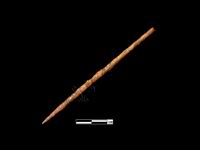 |
 |
Iron blade from the Site of Luliao
The fuller of this iron blade is flat, while its grind is arched. It is 8.4 cm long, 3.3 cm wide, and 5 mm thick. A wooden handle must be attached to the blade before use. The blade was unearthed at the Site of Luliao in Shalu Tonwship, Taichung County, in 2000, dated some 500 or 600 years ago. It belongs to the Papora of the Pinpu Tribes and was obtained through trade in Northern Taiwan.
|
 |
Agate Bead from the Site of Luliao
The agate bead has a hole, which seems to be punched from both sides. The bead, dated some 500 or 600 years ago, was unearthed at the Site of Luliao in Shalu Tonwship, Taichung County, in 2000. It belongs to the Papora of the Pinpu Tribes and was obtained through trade from abroad. According to Shujiang Huang's account of clothes and ornaments in “Customs of Aboriginal Tribes” and ”Tribes in North Road of Jhuluo” in his report entitled A Chinese Inspector's Travel Accounts of Taiwan, “The agate bead is called ‘Yadu’ [by the aboriginals].”
|
|
Copper Coin from Benxique, at the Site of Benkang
This copper coin was unearthed at the Site of Benxique in Benkang in 2003. It was buried some 100 years ago due to the flooding of the Beigang River. The inscription (the characters are usually read vertically) on the coin was engraved in seal script. The coin is 24 mm in diameter and 1 mm thick, weighed 2.3 g. The coin was made originally in Northern Sung Dynasty. This specimen is probably not the original, but a copy made by private coin maker.
|
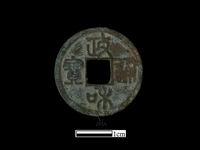 |
|
Ruins of An Old Well from Benxique, at the Site of Benkang
The old well was built in Qing Dynasty and buried some 100 years ago, due to the flooding of the Beigang River. Nowadays only the bottom of the well still exists. The ruins were unearthed at the Site of Benkang in 2003. The old well is 81 cm in external diameter and 70 cm in inner diameter, made of arch bricks. On each layer of the well, eight bricks were arranged into a circle. The base of the well was built on a round wooden board, which may have been an ox cart wheel. The board has a square hole (measured 53㎝×43㎝) at its center, with brick chips underneath as its base.
|
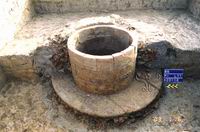 |
 |
Copper Button from Benxique, at the Site of Benkang
This copper button (shown in two different views of the same item) was unearthed at the Site of Benkang in 2003. It was buried some 100 years ago, due to the flooding of the Beigang River. The button is in the shape of a lotus seed head, with a ring on the back. It may be a button or part of an accessory on the garments worn by inhabitants of Benkang.
|
 |
Porcelain Plate in Underglaze Blue and White Decoration of A Crane with A Pine Tree, from the Site of Bantou Village
The porcelain ware was unearthed in Bantou Village, Singang, Jiayi County. The site used to be the office building for the Jiayi county governor and the local authority. Dated to approximately 200 years ago, the plate was made by Dehua Kiln in Fujan Province, decorated with patterns indicating good luck and longevity.
|
|































